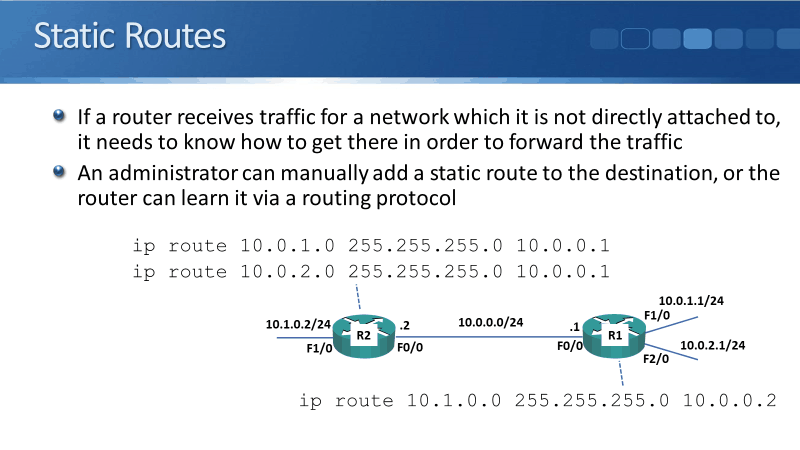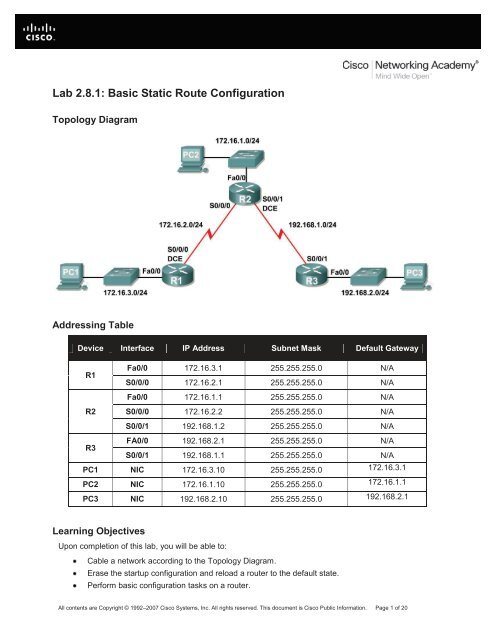

- Configuring static routes cisco packet tracer tutorial how to#
- Configuring static routes cisco packet tracer tutorial serial#
Static routes are one way we can communicate to remote networks. The figure shown below shows all the directly connected networks. The directly connected networks are the only networks that can be reached by a particular router. Since no other configuration has been made on these routers, R2 and R3, should only have directly connected routes.

By default, a router will only know of directly connected routes.ĭirectly connected routes in our scenario, from R1’s perspective are the network connected to HOST A and the network between R1 and R2. The output of the “show ip route” command on a router, shows the routes that a particular router can reach. The routing table is the database that contains information about various networks, we have said that these remote networks may either be learnt through routing protocols or manually configured routes. KEEP THIS TOPOLOGY IN MIND AS IT WILL BE USED THROUGHOUT THIS CHAPTER. In this chapter, we will explain the reasons as to why these two computers cannot communicate and resolve this problem. R3 can ping HOST B, R3 can ping R2’s s0/0/1 interface ONLY. In this scenario, R1 can ping HOST A, R1 can ping R2 s0/0/0 interface but not interface s0/0/1.
Configuring static routes cisco packet tracer tutorial serial#
The network administrator also configured R1’s and R3’s serial interfaces as the DCE and all other configurations are correct. As discussed earlier, each connection to a router should have its own network segment and this is shown in the diagram. The network above shows a small network consisting of 3 routers and 2 hosts. However, refer to the topology shown in the exhibit below. In previous chapters, we connected a router to computer and verified communication by using ping. The router uses a database known as the routing table to forward these packets. IntroductionĪs you may already know, the work of the router is to forward packets from the source device to the destination device.
Configuring static routes cisco packet tracer tutorial how to#
We will learn various concepts on static routes such as how to configure static routes, how the routing table bases its decisions, routing interfaces among other concepts. Routers in our networks discover remote networks in one of two ways In this chapter, we will learn static routing. In the next few chapters, we will look at how packets find their way in networks through routers. access-list 1 permit 192.168.1.0 0.0.0.Welcome to the world of routing. Note the wildcard mask used in the access-list configuration for the /24 network. The following configuration deny administrative access to the router except for the 192.168.1.0/24 network hosting admin workstations. The access-class command is used to apply the access list on the Virtual Terminal Line. Only numbered access-lists are supported on the Virtual Terminal Line.

Placing the ACL near the destination will make the trafic travel through the network before beeing blocked, resulting in bandwidth waste.Īccess-list 1 permit ip 10.2.25.0 0.0.0.255 10.1.0.0 0.0.255.255Īccess-list 101 permit icmp any 10.1.0.0 0.0.255.255 echoĪccess-list 1 deny ip any any Configuration on Cisco 2911 ISR Router Restrict remote telnet or SSH access to the ISR routerĪccess lists can be used to restrict remote SSH or Telnet access to the ISR router management interface (VTY) from specific networks only. This kind of ACL has to be placed near the source as it allows fine grained control to ressources accessed. Such ACLs can also be named access lists in which the ACL number is replaced by a keyword. In numbered ACLs, the access-list number can be any number from 100 to 199 or 2000 to 2699 (available in IOS versions >12.0.1).

This kind of ACL has to be placed near the destination to avoid blocking legitimate trafic from the source. The access-list number can be any number from 1 to 99. Traffic is filtered based on the source IP address of IP packets. Standard ACLs : This is the oldest ACL type which can be configured on Cisco routers.Two types of IP ACL can be configured in Cisco Packet Tracer 7.2 :


 0 kommentar(er)
0 kommentar(er)
